Picture |
Object
name
#NORAD |
Description |
Launch
Date |
Weight |
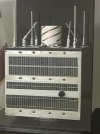
|
NAVID
#38075
(2012-005A) |
NAVID (Navid-e
Elm-o Sanat) is the third Iranian satellite.
It was built by the Iran University of Science and Technology.
It was placed into orbit by a new configuration of the
Safir carrier rocket on February 3rd
2012 at 00:04 UTC. The expected operational life time
is 18 months. The low earth orbit has a height of 382x283
km and an inclination of 56 degrees. It is an experimental
earth observation satellite. |
Feb
3rd 2012 |
50
kg |
  Enclosed
audio file as well as the spectrum plot and waterfall
diagram was recorded on February 5th
2012 around 00:30 UTC on 464.988 MHz while NAVID was
over Europe approaching Iran. Kindly provided by Darko
9A3LI. Enclosed
audio file as well as the spectrum plot and waterfall
diagram was recorded on February 5th
2012 around 00:30 UTC on 464.988 MHz while NAVID was
over Europe approaching Iran. Kindly provided by Darko
9A3LI.
|


|
LARES
#38077
(2012-006A) |
The new
Vega launcher of ESA started a flawless maiden flight
on Monday February 13th at
10:00 UTC. The launcher first deployed the main payload
LARES (Laser Relativity Spacecraft) into a circular
low earth orbit with a height of 1200km and an inclination
of 71°. Vega then made an additional firing of the
final OVUM stage before deploying the secondary cubesat
payloads into elliptical low earth orbits with perigees
around 350km and apogees around 1450 km. In total there
were 8 student built amateur radio satellites deployed.
You can find more details below.
I am searching for sound files. Please
send them to
 |
Feb 13th
2012 |
400 kg |
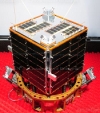
|
ALMASat-1
#38078
(2012-006B) |
ALMASat-1
(Alma Mater Satellite) was built by the University of
Bologna in Italy. This micro-satellite is a 30 cm cube
with a weight of 12.5 kg. Its primary downlink is at
437.465 MHz in 1200 bps AFSK (beacon every 2 minutes)
and in addition a beacon downlink is at 2407.850 MHz. |
Feb
13th 2012 |
12.5
kg |
 Enclosed
audio file was received and recorded on February 14th
at 16:51 UTC by Mike Rupprecht. Recording kindly provided
by Mike DK3WN. Enclosed
audio file was received and recorded on February 14th
at 16:51 UTC by Mike Rupprecht. Recording kindly provided
by Mike DK3WN.
|
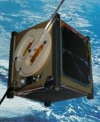
|
e-st@r
#38079
(2012-006C) |
e-st@r was built at Politecnico
di Torino in Italy. This nano-satellite has a weight
of 1 kg. Its primary mission is the demonstration of
an active 3-axis Attitude Determination and Control
system including an inertial measurement unit. Its downlink
is at 437.445 MHz in 1200 bps AFSK. The callsign is
E-STAR-I. After launch e-st@r was received by multiple
stations around the world. As he was strongly tumbling
he was put in "power save mode" to wait until
his attitude is stabilized.
I am searching for sound files. Please
send them to
 |
Feb 13th
2012 |
1 kg |

|
Goliat
#38080
(2012-006D) |
Goliat was built at the
University of Bucharest in Romania. This nano-satellite
has a weight of 1 kg. Its goal is to provide imaging
of the Earth surface using a digital camera and in-situ
measurement of radiation dose and micro-meteoroit flux.
Its beacon downlink is at 437.485 MHz transmitting telemetry
in 1200 bps AFSK as well as in CW (morse code) with
20 WPM. The downlink for the images is in the 2.4 GHz
ISM band with a speed of 115.2 kbps using a commecial
FHSS transceiver. |
Feb
13th 2012 |
1
kg |
 Enclosed
audio file was received and recorded on February 18th
at 06:30 UTC by Mike Rupprecht. Recording kindly provided
by Mike DK3WN. Enclosed
audio file was received and recorded on February 18th
at 06:30 UTC by Mike Rupprecht. Recording kindly provided
by Mike DK3WN.
|
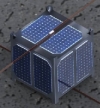
|
Robusta
#38084
(2012-006H) |
Robusta (Radiation on
Bipolar Test for University Satellite Application) was
built at the University of Montpellier in France. This
nano-satellite has a weight of 1 kg. Its purpose is
to test and evaluate radiation effects (low dose rate)
on bipolar transistor electronic components. Robusta
has a telemetry downlink at 437.325 MHz in 1200 bps
FM with one data burst of 20 seconds every 3 minutes.
Following the thermal vacuum test the Robusta development
team recommends to listen between 437.325 and 437.350
MHz. Faint signals were heard after the launch but soon
after no more signals were received.
I am searching for sound files. Please
send them to
 |
Feb 13th
2012 |
1 kg |
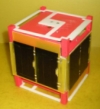
|
UniCubeSat
GG
#38085
(2012-006J) |
UniCubeSat GG (University
CubeSat - Gravity Gradient) was built at the University
of Rome in Italy. This nano-satellite has a weight of
1 kg. The UNICubeSat mission goal is the in situ
measurement of atmospheric density. Its downlink frequency
is 437.305 MHz in 9k6 FSK. There have been no reports
of reception of this satellite.
I am searching for sound files. Please
send them to
 |
Feb 13th
2012 |
1 kg |
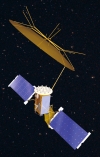

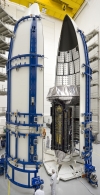
|
MUOS 1
#38093
(2012-009A) |
The MUOS-1
spacecraft is the first of planned five in the next-generation
narrowband tactical satellite communications system
that will replace the legacy Ultra High Frequency Follow-On
system. Offering enhanced capabilities to the mobile
warfighter, MUOS will provide 10 times greater communications
capacity than the legacy system. MUOS-1 was launched
on February 24th 2012 from
Cape Canaveral Air Force Station, Fla., on an Atlas
V launch vehicle. It is probably stationed in a geostationary
orbit at 177° West.
I am searching for sound files. Please
send them to
 |
Feb 24th
2012 |
6740 kg |
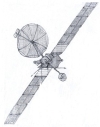
|
FIA
Radar 2
USA-234
NROL-25
#38109
(2012-014A) |
FIA Radar 2 (USA
234. NROL-25) is the second of the FIA Radar satellites,
and the third launch (assuming that the failed USA 193
was the first) in the Future Imagery Architecture (FIA)
series. It was launched on April 3rd 2012
at 23:12 GMT on a Delta IV rocket from Space Launch
Complex 6 at Vandenberg Air Force Station in California
into a circular retrograde orbit with an altitude of
1080 km and an inclination of 123 degree. The satellite
ceased transmissions of a continuous tone on 2242.5
MHz sometime on April 9th 2012. |
Apr
3rd 2012 |
|
FIA (Future Image Architecture)
Radar 2 was received on April 6th
2012 by Greg Roberts. He generated enclosed frequency
plot versus time which allows the assessment of the
doppler-shift behaviour.
 There
are actually four satellites in this picture: There
are actually four satellites in this picture:
-
the satellite starting on left edge and just starting
to go through time of closest approach is USA 179
-
then comes the doppler curve of FIA-Radar-2
- the
three parallel lines beneath USA 179 are a SDS satellite
to his west - main carrier red with two sidebands
-
then at right edge the bright whitish trace is the SDS
satellite to his east.
The reason the intensities
of the two geostationary satellites varies is because
he was using a directional helical antenna to follow
FIA-Radar-2. Ignore all other horizontal lines... |
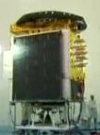
|
Beidou
M4
BD-2 M4
#38251
(2012-018B) |
Beidou M4, a Chinese
navigation satellite, was launched from Xichang on April
29th 2012
at 20:50 UT by a Long March 3B rocket jointly with Beidou
M3 into a highly inclined MEO. It was the first time
China launched a dual-satellite primary payload into
high-altitude orbit. Both satellites are part of the
Beidou navigation constellation, also known as the Compass
Navigation Satellite System (CNSS), China's second-generation
satellite navigation system. CNSS is capable of providing
continuous, real-time passive 3D geo-spatial positioning
and speed measurement. |
Apr
29th 2012 |
1100
kg |
 The
S-Band downlink of Beidou M4 on 2256 MHz was received
and enclosed FFT plot was generated in May 2014 by Milen
Rangelov. The
S-Band downlink of Beidou M4 on 2256 MHz was received
and enclosed FFT plot was generated in May 2014 by Milen
Rangelov.
|

|
Meteosat-10
MSG-3
#38552
(2012-035B) |
Meteosat-10 is a geostarionary
weather satellite stationed at 0 degree longitude. It
transmits LRIT data (128 kbps) at 1691 MHz and HRIT
data (1.0 Mbps) at 1695.150 MHz. In addition there is
a downlink to the primary ground station (3.27 Mbps)
at 1686.833 MHz. |
July
5th 2012 |
2037
kg |
  Enclosed
signal from Meteosat-10 was received on November 11th
2017 at 1691 MHz in USB. This is the LRIT downlink signal
with a bandwidth of 660kHz and a data rate of 128kbps. Enclosed
signal from Meteosat-10 was received on November 11th
2017 at 1691 MHz in USB. This is the LRIT downlink signal
with a bandwidth of 660kHz and a data rate of 128kbps.
 Enclosed
spectrum and waterfall diagrams show the signal with
good SNR. Enclosed
spectrum and waterfall diagrams show the signal with
good SNR.
|
  Meteosat-10
also features a TT&C beacon on 2242.500 MHz. This
is alsways a nice test signal when testing an S-band
setup. Enclosed recording and spectrum plot was received
on February 12th 2018 at 13:00
UTC by DD1US. The audio recording of the carrier was
done in CW mode-. You can see sidebands of the carrier
on the waterfall display. Meteosat-10
also features a TT&C beacon on 2242.500 MHz. This
is alsways a nice test signal when testing an S-band
setup. Enclosed recording and spectrum plot was received
on February 12th 2018 at 13:00
UTC by DD1US. The audio recording of the carrier was
done in CW mode-. You can see sidebands of the carrier
on the waterfall display.
|
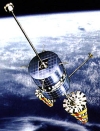
|
COSMOS
2481
KOSMOS 2481
Strela-3 #143
#38733
(2012-041A) |
Cosmos 2481 was launched
by a Rokot-KM rocket from Plesetsk July 28th2012.
COSMOS 2481 is used for store-dump communications by
Russian government and military. |
July
28th 2012 |
200
kg |
  COSMOS
2481 was received by Roland Proesch DF3LZ on October
12th 2013 at 19:06 UTC on 244.5125
MHz in USB. COSMOS
2481 was received by Roland Proesch DF3LZ on October
12th 2013 at 19:06 UTC on 244.5125
MHz in USB.
The spectrogam shows the ID of the satellite.
Sound file kindly provided by Roland Proesch DF3LZ.
|

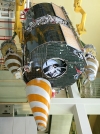
|
GONETS
M04
15L
#38736
(2012-041D) |
Gonets-M
are upgraded versions of the Gonets satellites, a civilian
derivate of the military Strela-3 satellite system.
They are store-dump communications satellites for Russia's
civilian system. Gonets M4 was launched together with
COSMOS 2481. |
July
28th 2012 |
280
kg |
  GONETS
M04 was received by Roland Proesch DF3LZ on January
2nd 2014 at 19:07 UTC on 263.085
MHz in USB. GONETS
M04 was received by Roland Proesch DF3LZ on January
2nd 2014 at 19:07 UTC on 263.085
MHz in USB.
The spectrogam shows the multitone sigal.
Sound file kindly provided by Roland Proesch DF3LZ.
|

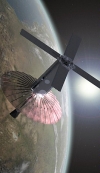
|
AENEAS
KE6YFA-1
#38760
(2012-048C) |
Aeneas
is a nanosatellite project of the University of Southern
California/Space Engineering Research Center (USC/SERC).
It uses a modified 3U (30 × 10 × 10 cm)
cubesat. The primary purpose of this satellite is to
track cargo containers over the open ocean with a 1-watt
WiFi-like transceiver (using 2425 MHz) and a custom-built
deploy-able mesh antenna. It also features a 70cm beacon
transmitting on 437.600 MHz an AX25 1200bd AFSK signal
using the callsign KE6YFA-1. |
Sept
13th 2012 |
4
kg |
  AENEAS'
70cm downlink was received one day after launch by Mike
Rupprecht DK3WN on September 14th
2012 at 12:15h UTC. AENEAS'
70cm downlink was received one day after launch by Mike
Rupprecht DK3WN on September 14th
2012 at 12:15h UTC.
He decoded the following telemetry:
KE6YFA-1>CQ,TELEM:
4341455255531D0040020001010
B0600181EFB030000001000F07
5007E7213004167DB45A7A407
Spectrum plot and audio recording kindly provided by
DK3WN.
|
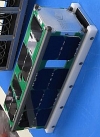
|
CSSWE
#38761
(2012-048D) |
The Colorado Student
Space Weather Experiment (CSSWE) is an NSF-funded 3U
CubeSat (30×10×10 cm) which houses an energetic
particle telescope. It transmits bursts every 18 seconds
on 437.345 MHz in 9k6 FSK AX.25, FM. |
Sept
13th 2012 |
4
kg |
 CSSWE
was received one day after launch by Mike Rupprecht
DK3WN on September 14th 2012
at 12:21h UTC. Spectrum plot and audio recording kindly
provided by DK3WN. CSSWE
was received one day after launch by Mike Rupprecht
DK3WN on September 14th 2012
at 12:21h UTC. Spectrum plot and audio recording kindly
provided by DK3WN. |
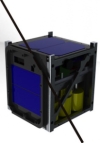
|
CalPoly-5
CP5
#38763
(2012-048F) |
CP5 is a 1U CubeSat developed
by Cal Poly's PolySat Program. The payload is designed
to test a deployable spacecraft de-orbiting thin-film
mechanism. The mechanism consists of a miniature solar
sail, similar to the ones used by NanoSail-D or LightSail
but much smaller in size. It transmits bursts every
2 minutes on 437.405 MHz 1k2 AFSK AX.25, LSB with an
output power of 1 W. |
Sept
13th 2012 |
1
kg |
  CP5 was
received one day after launch by Mike Rupprecht DK3WN
on September 14th 2012 at 08:58h
UTC. Spectrum plot and audio recording kindly provided
by DK3WN. CP5 was
received one day after launch by Mike Rupprecht DK3WN
on September 14th 2012 at 08:58h
UTC. Spectrum plot and audio recording kindly provided
by DK3WN.
|
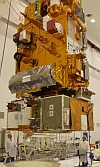


|
METOP-B
#38771
(2012-049A) |
METOP (Meteorological
Operational) is Europe's first polar-orbiting operational
meteorological satellite. It is the European contribution
to the Initial Joint Polar System (IJPS), a co-operative
agreement between Eumetsat and the US National Oceanic
and Atmospheric Administration (NOAA) to provide data
for climate and environmental monitoring and improved
weather forecasting. Metop-A was launched in 2006, Metop-B
followed in 2012, Metop-C is scheduled for 2018.
The downlinks are
all digital with RHCP and as follows:
Service Frequency
Bandwidth
Data rate
GDS
7800 MHz
63000
kHz
70000
kbps
AHRPT
1701.3 MHz
4500
kHz
3500
kbps
AHRPT
1707 MHz
4500
kHz
3500
kbps
LRPT
137.1 MHz
150
kHz
72
kbps
LRPT
137.9125 MHz
150
kHz
72
kbps
ADCS
465.9875 MHz
1
kHz
0.2/0.4
kbps
Unfortunately LRPT is not activated
due to a problem in the satellite. |
Sept
17th 2012 |
4424
kg |
  On October
17th 2017 at 09:28h UTC DD1US
received the AHRPT downlink signal on 1701.3 MHz. You
can find a WFM audio recording and a spectrum plot above. On October
17th 2017 at 09:28h UTC DD1US
received the AHRPT downlink signal on 1701.3 MHz. You
can find a WFM audio recording and a spectrum plot above.
 Below
you can find a picture which was decoded and kindly
provided by USA-Satcom from the recorded I/Q-data of
DD1US. Below
you can find a picture which was decoded and kindly
provided by USA-Satcom from the recorded I/Q-data of
DD1US.
|
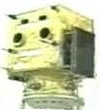
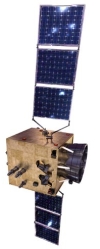
|
VRSS-1
Francisco Miranda
#38782
(2012-052A) |
VRSS 1 is Venezuela's
first remote sensing satellite. Its mission is to help
the country monitor its territory, specifically helping
it protect its environment, monitor disasters, estimate
agricultural harvests and plan the urban environment.
In 2012, it has been renamed Francisco Miranda. It was
built by China Great Wall Industry Cooperation (CGWIC),
a subsidiary of China Aerospace Science and Technology
Corporation (CASC). The
VRSS-1 satellite was launched on a CZ-2D (2) launch
vehicle, developed by Shanghai Academy of Spaceflight
Technology, from Jiuquan Satellite Launch Center into
a 654km LEO. |
Sept
29th 2012 |
880
kg |
 The
S-Band downlink on 2243 MHz of VRSS-1 was received and
enclosed FFT plot was generated in May 2014 by Milen
Rangelov. The
S-Band downlink on 2243 MHz of VRSS-1 was received and
enclosed FFT plot was generated in May 2014 by Milen
Rangelov.
|
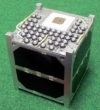
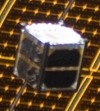
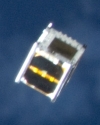
|
FITSAT-1
NIWAKA
#38853
(1998-067CP) |
FITSAT-1 is a 10cm cube,
and the weight is 1.33kg. It was built by the Fukuoka
Institute of Technology. The main mission of FITSAT-1
is to demonstrate a high speed 115.2kbps FSK downlink
on 5.8 GHz. It shall send a VGA (640x480pix) resolution
jpeg image data at in 5 to 6 seconds. The second mission
goal is to make the satellites twinkles as an ‘artificial
star’ using high-output LEDs. FITSAT-1 was deployed
from ISS on October 4th at
15:44 UTC.  Enclosed
picture of the ISS was taken by FITSAT-1 shortly after
its deployment. Beside the downlink for picture transmission
on 5.840 GHz, (115.2 kBit/s FSK) FITSAT-1 features downlinks
on 437.445 MHz (1k2 AFSK AX.25, FM) and a CW beacon
on 437.250 MHz (also FM modulation). Enclosed
picture of the ISS was taken by FITSAT-1 shortly after
its deployment. Beside the downlink for picture transmission
on 5.840 GHz, (115.2 kBit/s FSK) FITSAT-1 features downlinks
on 437.445 MHz (1k2 AFSK AX.25, FM) and a CW beacon
on 437.250 MHz (also FM modulation). |
Oct.
4th 2012 |
1.3
kg |
 Enclosed
CW signal was received and recorded on October 6th
2012 at 21:29 GMT on 437.258 MHz by DD1US. Enclosed
CW signal was received and recorded on October 6th
2012 at 21:29 GMT on 437.258 MHz by DD1US.
|
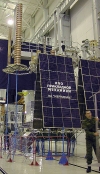
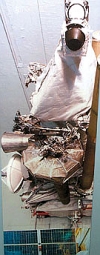
|
Meridian
6
Meridian 16 L
#38995
(2012-063A) |
Meridian 6 is a Russian
military/government communications satellite launched
on a Soyuz 2-1a rocket with a Fregat upper stage from
Plesetsk, Russia. Meridian combines the military and
civilian tasks of the former Molniya-1 and Molniya-3
satellites, together with the clandestine communications
function of the outgoing LEO Parus satellites. Meridian
6 has a highly elliptical orbit (HEO) with an inclination
of 63°, also called Molniya orbit. Meridian 6 has
multiple transponders:
P-Band downlink: 277.4 -
278.4 MHz,
UHF-Band downlink: 484.250 MHz 38 kHz
wide,
C-Band downlink: approx. 3600 MHz. |
Nov.
14th 2012 |
>
2000 kg |
 On December
31st 2014 at 11:33 UTC Paul
Marsh received a low data rate FSK signal on the C-Band
downlink at 3610 MHz of Meridian 6 C. Audio recording
kindly provided by Paul Marsh M0EYT. On December
31st 2014 at 11:33 UTC Paul
Marsh received a low data rate FSK signal on the C-Band
downlink at 3610 MHz of Meridian 6 C. Audio recording
kindly provided by Paul Marsh M0EYT.
|
  On January
6th 2020 at 12:32 UTC Roland
Proesch received the X-band beacon of Meridian 6 at
7600 MHz. The second recording was recorded with a wider
bandwidth of 24kHz. Audio recordings kindly provided
by Roland Proesch DF3LZ. On January
6th 2020 at 12:32 UTC Roland
Proesch received the X-band beacon of Meridian 6 at
7600 MHz. The second recording was recorded with a wider
bandwidth of 24kHz. Audio recordings kindly provided
by Roland Proesch DF3LZ.
|
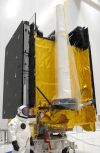
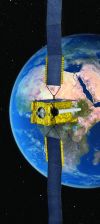
|
SKYNET
5D1
#39034
(2012-075A) |
SKYNET 5D is a military
communications satellite constructed and
operated by Astrium on behalf of the British
Ministry of Defence. It was launched on an Ariane 5 rocket
and the last of four Skynet 5 satellites. The Skynet
5D spacecraft is based on the Eurostar 3000S satellite
bus with its 34-metre solar arrays generating a minimum
of 6 kilowatts power. Downlinks are in UHF band
(so far reported 249.950, 253.500, 257.700 and 261.200
MHz) and X-band (7492.200MHz). The satellite's
payload includes jamming countermeasures. |
Dec.
19th 2012 |
4800
kg |
 The
spectum plot of the TTM signal at 7492.2 MHz was recorded
on January 4th 2013 at 09:51UTC
and kindly provided by Paul Marsh M0EYT from www.uhf-satcom.com. The
spectum plot of the TTM signal at 7492.2 MHz was recorded
on January 4th 2013 at 09:51UTC
and kindly provided by Paul Marsh M0EYT from www.uhf-satcom.com.
|
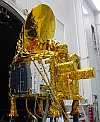
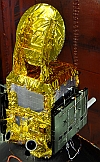
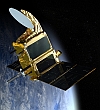
|
SARAL
#39086
(2013-009A) |
SARAL (Satellite
with ARgos and ALtika) was built and launched jointly
by ISRO in India and CNES in France. It was launched
with an Indian PSLV-CA rocket from Satish Dhawan Space
Centre into a circular sun synchroneous near polar orbit
with an inclination of 98.5° and an altitude of
785km. The SARAL mission is complementary to the Jason-2
mission of NASA/NOAA and CNES/EUMETSAT. It fills the
gap between Envisat and the Sentinel 3 mission of the
European GMES program. The combination of two altimetry
missions in orbit has a considerable impact on the reconstruction
of sea surface height (SSH), reducing the mean mapping
error by a factor of 4.
SARAL has an L-band
downlink at 1698.4 MHz with a bandwidth of 1 MHz and
a X-band downlink at 8212.5 MHz with a datarate of 105Mbit/s
. |
Feb
25th 2013 |
409
kg |
  SARAL
features also a A-DCS UHF downlink on 465.9875 MHz.
The downlink signal at 465.953 MHz was received on April
25th 2017 at 05:35 UTC by Patrick
Hajagos. Recording and waterfall plot kindly provided
by Patrick Hajagos. SARAL
features also a A-DCS UHF downlink on 465.9875 MHz.
The downlink signal at 465.953 MHz was received on April
25th 2017 at 05:35 UTC by Patrick
Hajagos. Recording and waterfall plot kindly provided
by Patrick Hajagos.
|

|
AAUSAT-III
AAUSAT-3
#39087
(2013-009B) |
AAUSAT 3
was a cubesat designed and built by students at Aalborg
University in Denmark.The purpose of the spacecraft
was to provide experience for advanced-level students
in the design and construction of space technology.
The spacecraft was designed to operate on a non-centralized
basis so it would be able to continue functioning even
when certain subsystems failed. It carried two automated
identification system (AIS) receivers -one based on
SDR principle. The images recorded by the satellite
were later transmitted to the ground station located
at Aalborg University, from which they were made accessible
for the general public. AAUSAT-3 transmits at 437.425
MHz in MSK 9k6, FM and also a CW beacon. It is using
the callsign OZ3CUB. |
Feb
25th 2013 |
0.8
kg |
 Enclosed
CW signal from AAUSAT-3 was received during orbit
#912 on April 30th 2013 by
Jean-Pierre F5YG. The CW signal is starting with "Start
of Message" -.-.- then "OZ3CUB B7.5 T37 +".
Recording kindly provided by Jean-Pierre Godet F5YG. Enclosed
CW signal from AAUSAT-3 was received during orbit
#912 on April 30th 2013 by
Jean-Pierre F5YG. The CW signal is starting with "Start
of Message" -.-.- then "OZ3CUB B7.5 T37 +".
Recording kindly provided by Jean-Pierre Godet F5YG.
|
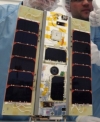
|
STRaND-1
#39090
(2013-009E) |
STRaND-1
(Surrey Training, Research and Nanosatellite Demonstrator
1) is using a three Cubesat (3U) module structure to
provide a quick and cost-effective framework to test
the applications of smartphone technology in space.
The 4.3 kg nanosatellite was launched into orbit on
board a PSLV Rocket from India on February 25th 2013
becoming the first smartphone satellite in space. Its
downlink is at 437.568
MHz 9k6 FSK AX.25 (later 19k2). |
Feb
25th 2013
|
4.3
kg |
  Enclosed
signals from STRaND-1 were received and recorded on
April 30th 2015 at 18:40 UTC
by Francisco EA7ADI. Recordings kindly provided by Francisco
EA7ADI. Enclosed
signals from STRaND-1 were received and recorded on
April 30th 2015 at 18:40 UTC
by Francisco EA7ADI. Recordings kindly provided by Francisco
EA7ADI.
|
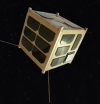
|
TUGsat
1
BRITE-Austria
BRITE-A
CANX 3B
#39091
(2013-009F) |
TUGSat 1
(Technische Universität Graz Satellit),
also known as BRITE-Austria
(BRIght-star Target Explorer - Austria),
is a mission to make photometric observations of some
of the brightest starts in the sky in order to examine
these stars for variability. The scientific instrument
is an optical camera with a high-resolution CCD to take
images from distant stars with magnitude of 3.5. The
observations will have a precision at least 10 times
better than achievable using ground-based observations,
and it will be packaged inside a CanX-class nanosatellite.
BRITE-Austria transmits on 2234.4 MHz in BPSK with datarates
between 32kbit/s and 26kbit/s. The transmit power is
500mW. |
Feb
25th 2013 |
7
kg |
 The
S-Band downlink of Brite-Austria was received and enclosed
FFT plot was generated in June 2014 by Milen Rangelov. The
S-Band downlink of Brite-Austria was received and enclosed
FFT plot was generated in June 2014 by Milen Rangelov.
|
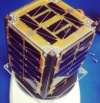
|
OSSI-1
#39131
(2013-015B) |
OSSI-1,
the Open Source Satellite Initiative satellite is a
cubesat developed by Hojun Song DS1SBO. In addition
to the radio beacons. OSSI-1 also carries a 44 watt
LED optical beacon to flash Morse Code messages to observers
on Earth.
OSSI-1 lifted
off on a Soyuz-2-1a with research satellites Bion-M1,
AIST and Dove-2 as well as other amateur radio CubeSats
from Launch Complex 31 at Baikonur in Kazakhstan
on Friday, April 19th 2013
at 1000 UTC. SOMP is expected to be released on April
21st 2013. The OSSI-1 CubeSat
was deployed from its Pod on the top of Bion-M1 at 16:15
UTC.
OSSI-1 has
a downlink in the 2m Amateur Radio band at 145.980
MHz with CW/1200Bd as well as in the 70cm Amateur Radio
band at 437.525 MHZ.
OSSI-1 was supposed to use the callsign DS1SBO. No signals
have ever been received since its release. |
Apr. 19th
2013 |
1 kg |
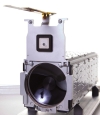
 |
DOVE-2
#39132
(2013-015C) |
DOVE-2 is
a commercial technology demonstrator from Cosmogia Inc
and is based a 3U cubesat structure with deployable
solar arrays. Dove 2 will also collect images of the
Earth. The mission of DOVE-2 is expected to last about
6 months. The orbit will be a 290 km by 575 km
LEO with an inclination of 64.9°.
DOVE-2 was launched together with
Bion-M1, AIST and some amateur radio satellites from Launch
Complex 31 at Baikonur in Kazakhstan on Friday, April
19th 2013 at 1000 UTC.
DOVE-2 has a downlink in the 450
MHz band and there is possibly also a downlink in the
2420.0 MHz band.
I am searching for sound files. Please
send them to
 |
Apr. 19th
2013 |
5.8
kg |
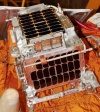

|
AIST-2
RS-43
#39133
(2013-015D) |
AIST-2
is a russian microsatellite developed
by a group of students, postgraduates and scientists
of Samara Aerospace University in cooperation with TsSKB-Progress.
It was launched on a Soyuz-2-1a with the Bion-M 1 satellite
on April 19th 2013. Two days
after the launch, TsSKB Progress announced that the
satellite had successfully separated from its host spacecraft
Bion-M1 on April 21st 2013
at 18:02 Moscow time. The satellite will measure the
geomagnetic field, test the new small space vehicle
bus, test methods to decrease microaccelerations to
a minimum level and measure micrometeoroids of natural
and artificial origin. It features uplink antennas for
145 MHz and downlink antennas for UHF.
AIST-2 transmits a CW beacon on 435.215
MHz using the callsign RS43.
I am searching for sound files. Please
send them to
 |
Apr. 19th
2013 |
53 kg |
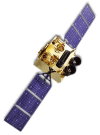
|
GAOFEN
Gaofen-1
GF 1
#39150
(2013-018A) |
Gaofen-1 is a Chinese
remote sensing satellite, possibly for cartography.
Its name means "high resolution" in English.
GF
1 is an optical satellite with a 2 m resolution pan-chromatic
camera, a 8 m resolution multi-spectral camera and a
16 m resolution wide-angle multi-spectral camera. It
will operate as part of a system to combine data from
satellites in orbit with data from sensors flown within
the atmosphere by aircraft. |
Apr
26th 2013 |
1080 kg |
 The
S-Band downlink on 2235.1 MHz of GAOFEN-1 was received
and enclosed FFT plot was generated in June 2014 by
Milen Rangelov. The
S-Band downlink on 2235.1 MHz of GAOFEN-1 was received
and enclosed FFT plot was generated in June 2014 by
Milen Rangelov.
|
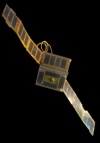
|
NEE-01
Pegaso
NEE-01 Pegasus
#39151
(2013-018B) |
NEE-01 Pegaso
is the first satellite from Ecuador. it is a 1U-Cubesat
built by the Ecuadorian Space Agency. The nano-satellite
was launched on a Chinese CZ-2D (2) rocket. The 1.2kg
Cubesat is 10cmx10cmx10cm and has 2 deployable solar
arrays with a span of 75cm. The spacecraft includes
a camera which will take pictures from space and transmits
them in SSTV (various modes) back to Earth. Furthermore
the satellite will transmit live video with a resolution
of 720p HD TV. The TV transmitter at 910 MHz will have
an output power of 0.9 Watts and a bandwidth of 25 MHz.
The effective transmit power is 2 Watts EIRP. NEE-01
Pegasus also includes a CW beacon. |
Apr.
26th 2013 |
1.2
kg |
 NEE-01
Pegasus is only transmitting when it is over Ecuador.
The signal is then received by their groundstation
and streamed in the internet. On the right you can see
a still picture extracted from such a video received
and streamed on May 20th 2013
at 15:39 UTC. Picture and enclosed video
stream recorded and kindly provided by Patrick
Hajagos. NEE-01
Pegasus is only transmitting when it is over Ecuador.
The signal is then received by their groundstation
and streamed in the internet. On the right you can see
a still picture extracted from such a video received
and streamed on May 20th 2013
at 15:39 UTC. Picture and enclosed video
stream recorded and kindly provided by Patrick
Hajagos.
|
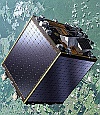
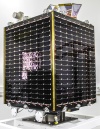
|
PROBA-V
#39159
(2013-021A) |
PROBA-V (Project
for On-Board Autonomy - Vegetation)
was launched on May 7th 2013
at 02:06 UTC as part of the VEGA VV02 mission as the
primary payload into a 820km circular orbit.
PROBA-V is operated by ESA (European
Space Agency). It is intended to be an improved smaller
version of the large VGT (Vegetation) optical instrument
of SPOT-4 and SPOT-5 mission and shall guarantee data
continuity for the Vegetation dataset once the current
Spot missions end. |
May
7th 2013 |
158
kg |
  PROBA-V
has an S-band downlink at 2235 MHz. The downlink
mode can be switched between CCSDS BPSK @ 329900 Baud
and a widseband mode. Enclosed spectrum plots show the
2 different modes. Signals were received on May 9th
2013 at 10:21 UTC and 12:03 UTC. Spectrum plots kindly
provided by Paul Marsh M0EYT. PROBA-V
has an S-band downlink at 2235 MHz. The downlink
mode can be switched between CCSDS BPSK @ 329900 Baud
and a widseband mode. Enclosed spectrum plots show the
2 different modes. Signals were received on May 9th
2013 at 10:21 UTC and 12:03 UTC. Spectrum plots kindly
provided by Paul Marsh M0EYT.
|
 In enclosed
audio file you can hear the central carrier changing
frequency and thus pitch due to doppler shift. Recorded
on May 9th at 12:05 UTC and
kindly provided by Paul Marsh M0YET. In enclosed
audio file you can hear the central carrier changing
frequency and thus pitch due to doppler shift. Recorded
on May 9th at 12:05 UTC and
kindly provided by Paul Marsh M0YET.
|
  This
audio-file and he spectrum were recorded on May 9th
2013 at 21:50 UTC at 2235 MHz when PROBA-V was in narrow
mode. The receiver was tuned in the middle of the data,
and what we can hear are the individual PSK carriers
caused by the data modulation. Due to doppler shift
it sounds like its one carrier going up and down, but
in reality its many carriers passing thru the RX passband.
Recording kindly provided by Paul Marsh M0YET. This
audio-file and he spectrum were recorded on May 9th
2013 at 21:50 UTC at 2235 MHz when PROBA-V was in narrow
mode. The receiver was tuned in the middle of the data,
and what we can hear are the individual PSK carriers
caused by the data modulation. Due to doppler shift
it sounds like its one carrier going up and down, but
in reality its many carriers passing thru the RX passband.
Recording kindly provided by Paul Marsh M0YET.
|
 The
S-Band downlink on 2235 MHz of Proba-V was received
and enclosed FFT plot was generated in May 2014 by Milen
Rangelov. The
S-Band downlink on 2235 MHz of Proba-V was received
and enclosed FFT plot was generated in May 2014 by Milen
Rangelov.
|
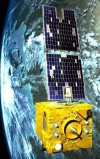
|
VNREDSAT
1
VNREDSAT-1A
#39160
(2013-021B) |
VNREDSat-1 (short for
Vietnam Natural Resources, Environment and Disaster
Monitoring Satellite) is the first optical Earth
Observing satellite of Vietnam.
It was built by EADS Astrium and its primary mission
is to monitor and study the effects of climate change,
predict and take measures to prevent natural disasters,
and optimise the management of Vietnam's natural resources.
 VNREDSAT-1A
has a S-band downlink at 2240 MHz which was reeived
by Paul Marsh M0EYT on May 9th
2013 21:32 UTC. Spectrum plot kindly provided by Paul
Marsh M0EYT. VNREDSAT-1A
has a S-band downlink at 2240 MHz which was reeived
by Paul Marsh M0EYT on May 9th
2013 21:32 UTC. Spectrum plot kindly provided by Paul
Marsh M0EYT.
I am searching for sound files. Please
send them to
 |
May 7th
2013 |
120 kg |

|
ESTCube-1
#39161
(2013-021C) |
ESTCube-1 is the first
Estonian satellite.It is a cubesat measuring 10 x 10
x 10 cm and weighing 1.33 kg.
It was built by students
from Tartu University, Estonian Aviation Academy, Tallinn
University of Technology and University of Life Sciences.
The satellite's payload has been developed in conjunction
with Finnish Meteorological Institute and German Space
Center (DLR).
The main mission of the satellite
is to test a novel space propulsion technology, an electric
solar wind sail.
ESTCube-1 transmits a CW beacon
with 19 wpm at 437.250 MHz with 100mW using the callsign
ES5E/S and a telemetry signal with 9600Bd FSK AX.25
at 437.505 MHz with 500 mW using the callsign ES5E-11.
EstCube-1 was launched on May 7th
2013 at 02:06 UTC as part of the VEGA VV02 mission with
the primary payload being PROBA-V. ESTCube-1 was dispensed
together with another secondary payload, VNREDSAT-1A,
from the VESPA secondary payload platform. |
May
7th 2013 |
1.33
kg |
 This
spectum plot of the ESTCube-1 CW beacon signal at 437.247
MHz was recorded on May 8th
2013 at 20:57UTC and kindly provided by Paul Marsh M0EYT. This
spectum plot of the ESTCube-1 CW beacon signal at 437.247
MHz was recorded on May 8th
2013 at 20:57UTC and kindly provided by Paul Marsh M0EYT.
|
 Enclosed
audio recording of the 9600Bd signal of ESTCube-1 was
received and recorded on May 9th
2013. It was kept as plain wav file (10 MByte large)
to allow others to decode it. Kindly provided by Mike
DK3WN. Enclosed
audio recording of the 9600Bd signal of ESTCube-1 was
received and recorded on May 9th
2013. It was kept as plain wav file (10 MByte large)
to allow others to decode it. Kindly provided by Mike
DK3WN.
|
  Enclosed
audio recordings of the CW beacon of ESTCube-1 were
received and recorded on May 9th
2013 at 21:27 UTC. Recordings kindly provided by Paul
Marsh M0EYT. Enclosed
audio recordings of the CW beacon of ESTCube-1 were
received and recorded on May 9th
2013 at 21:27 UTC. Recordings kindly provided by Paul
Marsh M0EYT.
|
 This
spectum plot of the 900bd signal of ESTCube-1 at 437.510
MHz was recorded on December 31st
2013 at 11:52UTC and kindly provided by Paul Marsh M0EYT. This
spectum plot of the 900bd signal of ESTCube-1 at 437.510
MHz was recorded on December 31st
2013 at 11:52UTC and kindly provided by Paul Marsh M0EYT.
|
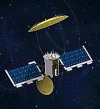
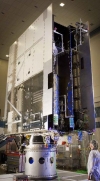
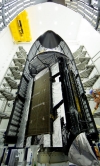
|
MUOS 2
#39206
(2013-036A) |
MUOS (Mobile
User Objective System) is a next-generation narrowband
tactical satellite communications system designed to
significantly improve ground communications for U.S.
forces on the move. MUOS serves a dual-provider of both
voice traffic currently routed by the Navy's existing
generation, albeit aging, Ultra High Frequency Follow-On
spacecraft, but it also creates a new era of mobile
communications built around 3G cellular technology to
relay narrowband tactical information such as calls,
data messaging, file transfers and email on rates of
up to 384 Kilobits per second. MUOS-2 was launched by
the USA on an ATLAS V from Cape Canaveral. It is probably
located on a geostationary orbit at 100° West.
I am searching for sound files. Please
send them to
 |
July 19th
2013 |
6740 kg |
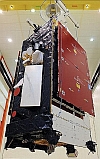


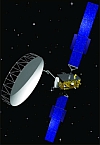
|
Alphasat
Alphasat I-XL
Inmarsat-4A F4
#392xx
(2013-038A) |
Alphasat
or Inmarsat-4A F4 (originally Alphasat I-XL or Inmarsat
XL) is a joint ESA and Inmarsat communications satellite
using the Alphabus proto-flight platform, achieving
in-orbit validation of the ESA initiated platform through
a commercial operator. Alphasat features
a new generation digital signal processor for the payload,
and a 12-meter aperture antenna reflector, the latest
in a line of successful AstroMesh deployable, large
aperture reflectors developed and built by Astro Aerospace.
The
spacecraft has an electrical power of 12 kW and an expected
lifetime of 15 years. Inmarsat
flew an extended L-band payload, in parallel to and
supporting its existing world-leading global mobile
satellite services. This Inmarsat mission definition
is based around multimedia mobile services already provided
by the current Inmarsat-4 satellites through Broadband
Global Area Network (GAN). The satellite is
positioned at 25 degrees east, with its coverage centred
over Africa and providing additional coverage to Europe,
the Middle-East and parts of Asia. |
July
25th 2013 |
6649
kg |
  Alphasat
is also transmitting the Outernet signal covering Europe
and Africa on 1546.250 MHz. Enclosed recording and spectrum
screenshots of the 5 kHz wide Alphasat
is also transmitting the Outernet signal covering Europe
and Africa on 1546.250 MHz. Enclosed recording and spectrum
screenshots of the 5 kHz wide  Outernet
signal were received on 1546.2497 MHz on December 3rd
2017. Outernet
signal were received on 1546.2497 MHz on December 3rd
2017.
|

|
KH-11
6
Crystal 16
USA 245
NROL 65
#39232
(2013-043A) |
Keyhole
KH-11 6 was launched on August 28th
2013 with a Delta-4H rocket from Vandenberg, This series
of satellites feature the Enhanced Imaging System (EIS)
and are believed to use a 2.4 m diameter prime
mirror, which would proved a theoretical ground resolution
of 15 cm. Operational resolution would be worse
due to effects of the atmosphere.
Enclosed spectrum plots of KH-11
6 were received and between August 30th
and September 3rd on 2242,502
MHz by Paul M0EYT.
 Initial
signal received on August 30th
2013. Initial
signal received on August 30th
2013.
 Another
pass showing the downlink in coherant mode, locked to
a groundstation, most likely at Thule AFB in Greenland. Another
pass showing the downlink in coherant mode, locked to
a groundstation, most likely at Thule AFB in Greenland.
 Strange
effects probably caused by reflections and nulling of
the S-Band downlink signal. Strange
effects probably caused by reflections and nulling of
the S-Band downlink signal.
Spectrum plots kindly provided by
Paul Marsh M0EYT. |
Aug 28th
2013 |
13500 kg |
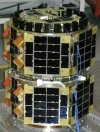
|
CUSat
Nanosat 4A
#39266
(2013-055B) |
CUSat
was built by Cornell-University in Ithake, NJ, USA.
It is an autonomous in-orbit inspection satellite system
and will allow to test the accuracy of the carrier-phase
differential GPS (CDGPS) to less than 10 cm by comparing
the CDGPS navigation solution to the known distance
between the GPS antennas. The satellite, being equipped
with a camera, will also capture imagery, of the Earth,
the Moon, and the comet ISON, and send these images
to a ground station on Earth. The nano-satellite is
also equipped with Pulsed Plasma Thrusters (PPTs). These
will be tested last, once the other mission objectives
have been verified. CUSat was launched on the maiden
Falcon-9.1.1 launch from Vandenberg AFB.
Beacon
Downlink Frequency:
437.405 MHz FM (UHF band)
Beaconed
Callsign:
BOTTOM
FCC
Callsign:
WG2XTI
Data
Rate:
1200 baud
Modulation:
AFSK
Transmit
Interval:
Every 1 minute
RF
Power Output:
2.2 W
Antenna
Polarization:
Linear
|
Sep
29th 2013 |
25
kg |
  Jan
PE0SAT received the 1200bd AFSK downlink signal of CUSat
on October 10th 2013 at 17:59
UTC on 437.4055 MHz. Recording kindly provided by Jan
van Gils PE0SAT. Jan
PE0SAT received the 1200bd AFSK downlink signal of CUSat
on October 10th 2013 at 17:59
UTC on 437.4055 MHz. Recording kindly provided by Jan
van Gils PE0SAT.
|

|
DANDE
NANOSAT 5
#39267
(2013-055C) |
DANDE
(Drag and Atmospheric Neutral Density
Explorer) is a low-cost satellite developed
at the University of Colorado at Boulder (CU) with about
150 students contributing. Measuring drag and neutral
particles in the lower atmosphere between 325-400 kilometers,
DANDE will be measuring real time density, quantifying
variations in altitude and over time, as well as providing
in-situ model calibration data. The satellite is a low-cost
density, wind, and composition measuring instruments
that will provide data for the calibration and validation
of operational models and improve our understanding
of the thermosphere. Weighing approximately 84 pounds,
DANDE is classified as a nano-satellite that is about
18 inches in diameter. DANDE transmits every15 seconds
on 436.750 MHz FM, 9k6 FSK with an output power of 750
mW. The antenna is linearly polarized. DANDE uses
the callsign "dandecosgc".
I am searching for sound files. Please
send them to
 |
Sept 29th
2013 |
50 kg |
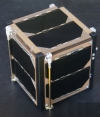
|
ArduSat
ArduSat-1
#39412
(2013-067DA) |
ArduSat (short for Arduino Satellite)
is a miniature cubic satellite with a payload computer
comprised of an array of AVR processors. It has a suite
of 25+ sensors, including three cameras, a Geiger counter,
spectrometer, magnetometer. The 1U cubesat was deployed
from ISS on November 19th 2013
at 12:18 UTC. Using the callsign WG9XFC-1 it transmits
on 437.325 MHz telemetry using 9600bps MSK/CCSDS encoding.
In addition it features a FSK-CW beacon at 437.000 MHz.
I am searching for sound files. Please
send them to
 |
Nov. 19th
2013 |
1 kg |

|
Pico
Dragon
#39413
(2013-067DB) |
Pico Dragon, the Made-in-Vietnam
micro satellite, was deployed together with three other
micro satellites of the United States from ISS on November
19th 2013 at 12:18 UTC. Using
the callsign XV0PID Pico-Dragon transmits a CW beacon
on 437.250 MHz with an output power of 100mW. In addition
it features a 1200Bd AFSK AX.25 downlink at 437.365
MHz with an output power of 800mW. |
Nov.
19th 2013 |
1
kg |
 Enclosed
CW signal from Pico Dragon was received during
orbit #592 on December 27th
2013 by Jean-Pierre F5YG. The CW signal is "5 PICODRAGON
VIETNAM 5". Recording kindly provided by Jean-Pierre
Godet F5YG. Enclosed
CW signal from Pico Dragon was received during
orbit #592 on December 27th
2013 by Jean-Pierre F5YG. The CW signal is "5 PICODRAGON
VIETNAM 5". Recording kindly provided by Jean-Pierre
Godet F5YG.
|
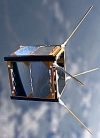
|
ArduSat
ArduSat-X
#39414
(2013-067DC) |
ArduSat (short for Arduino Satellite)
is a miniature cubic satellite with a payload computer
comprised of an array of AVR processors. It has a suite
of 25+ sensors, including three cameras, a Geiger counter,
spectrometer, magnetometer. The 1U cubesat was deployed
from ISS on November 19th 2013
at 12:18 UTC. Using the callsign WG9XFC-X it transmits
on 437.345 MHz telemetry using 9600bps MSK/CCSDS encoding.
In addition it features a FSK-CW beacon at 437.000 MHz.
I am searching for sound files. Please
send them to
 |
Nov. 19th
2013 |
1 kg |
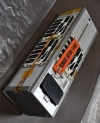
|
TechEdSat-3
Techedsat 3P
#39415
(1998-067DD) |
TechEdSat 3
(Technical and Educational Satellite
3) is a 3U CubeSat. It was built as
a conjoined project between San Jose State University
(SJSU) and the University of Idaho as a collaborative
engineering project, with oversight from the NASA Ames
Research Center. TechEdSAT-3p is the first flight test
of an Exo-Brake passive de-orbit system. Building on
the predecessor, TechEdSAT-3p is a triple cubesat (3U)
with a set of dual advanced avionics systems powered
by the previous core system. In 2U of the packaging
(roughly 2/3 of the volume), there is stowed an erectable
deployment system that would place the Exo-Brake in
the desired orientation. It was deployed from ISS on
November 20th 2013.
TechEdSat-3p has a designated downlink
frequency of 437.465 MHz (1200bd AFSK AX.25 800mW).
TechEdSat-3 was decayed in January
2014.
I am searching for sound files. Please
send them to
 |
Nov. 20th
2013 |
4 kg |

|
Trailblazer-1
SPA-1 Trailblazer
#39400
(2013-064W) |
Trailblazer
is a Cubesat built from the Configurable Space Research
at the University of New Mexico (Craig
KE5VSH). Trailblazer
transmits telemetry every 50 seconds at 437.425MHz in
AX.25,/ 9600Bd.
No
signals have been received yet.
I am searching for sound files. Please
send them to
 |
Nov. 20th
2013 |
1 kg |
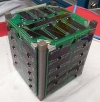
|
DragonSat-1
#39383
(2013-064D) |
DragonSat-1
was built at Drexel University and the US Naval University
(Jin KB3UKS). The mission of DragonSat-1 is to take
pictures of the northern and southern aurora to observe
the radiation dissipation intensity during the solar
events. It is also planned to perform a technology demonstration
of boom deployment mechanism in space. DragonSat
transmits telemetry every 30 seconds at 145.870 MHz
in AX.25 / 9600 Bd.
No
signals have been received yet.
I am searching for sound files. Please
send them to
 |
Nov. 20th
2013 |
1 kg |
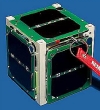
|
SwampSat
#39402
(2013-064Y) |
SwampSat
is a 1U student-developed CubeSat mission of the University
of Florida (UFL) in Gainesville, FL, USA. The goal of
the project is to advance the TRL (Technology Readiness
Level) of CMGs (Control Moment Gyroscopes) appropriate
for smallsats, as a means of increasing the capabilities,
and hence the utility of CubeSats. Using the callsign
WG4SAT it transmits on 437.385 MHz a 9600bps telemetry
signal in FSK AX.25 every 60 seconds with 1 Watt output
power.
I am searching for sound files. Please
send them to
 |
Nov. 20th
2013 |
1 kg |
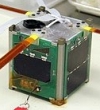
|
COPPER
#39395
(2013-064R) |
COPPER (Close
Orbiting Propellant Plume and Elemental Recognition)
is a 1U CubeSat to flight-test the use of a commercial
microbolometer (long-wave infrared imager) for Earth
observing and space situational awareness. Using the
callsign COPPER it transmits on 437.290 MHz a 9600bps
telemetry signal in FSK AX.25 every 10 seconds.
I am searching for sound files. Please
send them to
 |
Nov. 20th
2013 |
1 kg |
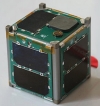
|
Vermont
Lunar Cubesat
#39407
(2013-064AD) |
Vermont Lunar Cube’s
primary mission is to make navigation estimates for
a future moon project, in which another cube satellite
will orbit the moon. The satellite was built by Vermont
Technical College and transmits on 437.305 MHz a 9600bps
telemetry signal in FSK AX.25 every 60 seconds. |
Nov.
20th 2013 |
1
kg |
 On May
6th 2015 at 17:31 UTC Francisco
EA7ADI received enclosed signal which he thinks came
from Vermont Lunar Cubesat. Recording kindly provided
by Francisco EA7ADI. On May
6th 2015 at 17:31 UTC Francisco
EA7ADI received enclosed signal which he thinks came
from Vermont Lunar Cubesat. Recording kindly provided
by Francisco EA7ADI.
|
 Also on
August 2nd 2015 at 18:54 UTC
Francisco EA7ADI received the Vermont Lunar Cubesat
on 437.305 MHz. Recording kindly provided by Francisco
EA7ADI. Also on
August 2nd 2015 at 18:54 UTC
Francisco EA7ADI received the Vermont Lunar Cubesat
on 437.305 MHz. Recording kindly provided by Francisco
EA7ADI.
|
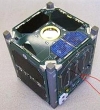
|
NPS-SCAT
#39389
(2013-064K) |
NPS-SCAT
(Naval Postgraduate School Solar Cell Array Tester)
has the objective, to provide a responsive platform
to test solar cells in orbit while focusing on the education
of NPS students. The 1U cubesat transmits on 437.525
MHz a 1200bps AFSK telemetry signal in AX.25 every 5
minutes. In addition the NPS-SCAT CubeSat contains two
half duplex amateur radio systems, an MHX 2400 (S-Band,
2.4 GHz) and a UHF Transceiver (UHF, 437.525 MHz). The
S-band downlink frequency is in the range of 2401.200-2447.600
MHz.
I am searching for sound files. Please
send them to
 |
Nov. 20th
2013 |
1 kg |
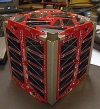
|
TJ3SAT
TJ3SAT
#39385
(2013-064F) |
TJ3SAT (Thomas
Jefferson Cubesat) is a joint project between the Thomas
Jefferson High School for Science and Technology and
industry partners to design and build a CubeSat to increase
interest in aerospace technology, as part of NASA's
Educational Launch of NanoSatellites (ELaNa) program.
The 1U cubesat transmits on 437.320
MHz a CW beep every 13.5 seconds and in addition a CW
identifier every 10 minutes.
I am searching for sound files. Please
send them to
 |
Nov. 20th
2013 |
1 kg |
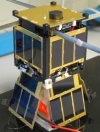
|
KySat-2
#39384
(2013-064E) |
KySat-2 was built
by Space Systems Lab, University of Kentucky/USA. It
was launched together with a large number of CubeSats
carrying amateur radio payloads on a Minotaur-1 rocket
from NASA’s Wallops Flight Facility in Wallops Island,
Va., on November 20th 2013 at 01:15 UTC. KySat-2 features
a 5 megapixel digital camera, a temperature sensor,
a 3-axis MEMS rate gyroscope, a 3-axis magnetometer,
and a “stellar gyroscope” which was developed by University
of Kentucky students. When in sunlight KySat-2 (using
the callsign KK4AJJ) transmits on 437.405 MHz every
15 seconds telemetry in 9k6 FSK using the AX.25 protocol
with a transmit power of 1 Watt.
I am searching for sound files. Please
send them to
 |
Nov. 20th
2013 |
1 kg |
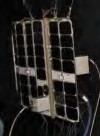 |
SENSE SV1
#39388
(2013-064J) |
The SENSE
(Space Environmental NanoSat Experiment)
program is a rapid development effort of the USAF Space
and Missiles Center Development Planning Directorate
(SMC/XR) which will demonstrate the capability of NanoSats
to perform space missions in an affordable and resilient
manner.
The three primary objectives for
the SENSE mission are: 1) to develop best practices
for operational CubeSat/NanoSat procurement, development,
test, and operations; 2) to mature CubeSat bus and sensor
component technology readiness levels; and 3) to demonstrate
the operational utility of CubeSat measurements by flowing
validated, low-latency data into operational space weather
models.
One satellite has a Cubesat Tiny
Ionospheric Photometer (CTIP) monitoring 135.6 nm
photons produced by the recombination of O+
ions and electrons.
Sense SV1 features a 1 Mb/s downlink
& 4 kb/s uplink S-Band transceiver w/ AES 256 Type
II Encryption.
I am searching for sound files. Please
send them to
 |
Nov. 20th
2013 |
3.4 kg |
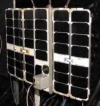
|
SENSE SV2
#39392
(2013-064N) |
The other
satellite has a Wind Ion Neutral Composite Suite (WINCS)
to acquire simultaneous co-located, in situ measurements
of atmospheric and ionospheric density, composition,
temperature and winds/drifts. Mission data will be used
to improve current and future space weather models and
demonstrate the utility of data from CubeSats for operational
weather requirements.
Sense SV1 features a 1 Mb/s downlink
& 4 kb/s uplink S-Band transceiver w/ AES 256 Type
II Encryption.
I am searching for sound files. Please
send them to
 |
Nov. 20th
2013 |
3.5 kg |
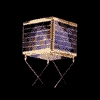 |
AprizeSat
7
exactView 5R
EV 5R
#39416
(2013-066A) |
LatinSat,
later renamed AprizeSat,
is a constellation of small Low-Earth-Orbit satellites
(64 satellites planned) to achieve a global communication
system of data transmission and fixed and mobile asset
tracking and monitoring (GMPCS). The satellites also
carry experimental payloads. AprizeSat 3 to 10 also
feature an AIS (Automatic Identification System) receiver
to gather position data from ships. |
Nov.
21st 2013 |
12
kg |
  This spectum
plot of AprizeSat 7and the corresponding audio file
was recorded on October 15th
2015 at 400.585 MHz and kindly provided by Maik Hermenau. This spectum
plot of AprizeSat 7and the corresponding audio file
was recorded on October 15th
2015 at 400.585 MHz and kindly provided by Maik Hermenau.
|

|
ZACube-1
TshepisoSat
ZA-003
#39417
(2013-066B) |
South Africa
ZACube-1 TshepisoSat is a Cubesat built by students
at Cape Peninsula University of Technology (CPUT) in
Cape Town. Its main payload is a high frequency (HF)
beacon transmitter that will be used to help characterize
the Earth’s ionosphere and to calibrate SANSA's (South
African National Space Agency) auroral radar installation
at the SANAE-IV base in Antarctica. The UHF telemetry
beacon transmits on 437.345 MHz. The uplink frequency
is 145.860 MHz. It also features an
HF beacon on
14.099 MHz.
 On
December 14th 2013 a first
picture was received. Image credit CPUT FSATI. On
December 14th 2013 a first
picture was received. Image credit CPUT FSATI.
I am searching for sound files. Please
send them to
 |
Nov. 21st
2013 |
1 kg |


|
Skysat
1
#39418
(2013-066C) |
Commercial
remote sensing satellite for Skybox Imaging of the USA.
It will collect high resolution panchromatic and multispectral
images of the Earth. SkySat-1's
main TT&C downlink is 8375 MHz (RHCP), the backup
downlink is 8380 MHz (RHCP). Data downlinks in 8PSK
45MSps are at 8075 MHz, 8200 MHz and 8325 MHz. Uplinks
are at 2081 MHz (RHCP) and 2083 MHz (RHCP).
I am searching for sound files. Please
send them to
 |
Nov. 21st
2013 |
100 kg |
 |
Dubaisat
2
DubaiSat-2
#39419
(2013-066D) |
Earth observation satellite
built by the Emirates Institution for Advanced Science
and Technology for the Satrec Initiative, a satellite
manufacturing company in South Korea. Its purpose is
to obtain images for commercial users in the United
Arab Emirates. Designated frequencies are 2228.25 MHz,
2228.3 MHz and 2269.300 MHz. |
Nov.
21st 2013 |
300
kg |
 This
spectum plot of Dubaisat 2 at 2228.25 MHz was recorded
on January 3rd 2014 at 23:11UTC
and kindly provided by Paul Marsh M0EYT. This
spectum plot of Dubaisat 2 at 2228.25 MHz was recorded
on January 3rd 2014 at 23:11UTC
and kindly provided by Paul Marsh M0EYT.
|
 The
S-Band downlink on 2228.3 MHz of DubaiSat-2 was received
and enclosed FFT plot was generated in May 2014 by Milen
Rangelov. The
S-Band downlink on 2228.3 MHz of DubaiSat-2 was received
and enclosed FFT plot was generated in May 2014 by Milen
Rangelov.
|
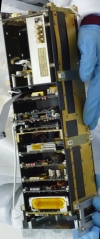
|
OPTOS
#39420
(2013-066E) |
OPTOS
(Optical Nanosatellite) is a low-cost
3 Unit CubeSat project of INTA (Instituto Nacional de
Tecnica Aerospacial) the Spanish Space Agency, Madrid.
It transmits on 402.00 MHz with a downlink datarate
between 3.5 - 10 kbit/s (typically 5 kbits/s) PM/BPSK. |
Nov.
21st 2013 |
3
kg |
 This
spectum plot of OPTOS at 402 MHz was recorded on December
27th 2013 and kindly provided
by Maik Hermenau. This
spectum plot of OPTOS at 402 MHz was recorded on December
27th 2013 and kindly provided
by Maik Hermenau.
|
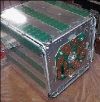



|
Unisat
5
#39421
(2013-066F) |
Small satellite
built by university students and researchers for GAUSS
(Group of Astrodynamics of the University of Roma “La
Sapienza”). Onboard equiment includes the GlioSat biomedical
experiment to investigate the effects of microgravity
and ionizing radiation on cell behaviour, and a digital
Earth-imaging system. Unisat also contains a Cubesat
deployer MRFOD (Morehead-Roma FemtoSat Orbital Deployer)
- a student-built technology demonstrator for deploying
satellites containing Eagle 1, Eagle 2, Wren and QBScout
1, PEPPOD CubeSat deployment system containing Dove
4, and a second PEPPOD containing iCube 1, HUMSAT-D
and PUCPSat-1/Pocket PUCP. The small satellites currently
remain within Unisat 5. UniSat 5 features UHF downlinks
at 437.175 MHz and 437.425 MHz (9600bps GMSK).
I am searching for sound files. Please
send them to
 |
Nov. 21st
2013 |
10
kg |


|
STSat
3
#39422
(2013-066G) |
Science
satellite from South Korea carrying two principal sensors.
MIRIS (Multi-purpose Infrared Imaging System) is for
astronomy, providing infrared imagery of the galaxy
and of the cosmic background . COMIS (Compact Imaging
Spectrometer) is an instrument to provide infrared imagery
for Earth environmental monitoring, land classification
research, and monitoring of water quality.
I am searching for sound files. Please
send them to
 |
Nov. 21st
2013 |
150
kg |
 |
WNISat
1
#39423
(2013-066H) |
WNISAT 1
(Weather News Inc. Satellite 1) is a nanosatellite for
north arctic routes and atmosphere monitoring. The project
is started from the commercial objects between Weathernews
and Axelspace. The object of the WNISAT-1 mission is
monitoring of the Northern sea routes and of the CO2
content of the atmosphere.
I am searching for sound files. Please
send them to
 |
Nov. 21st
2013 |
10 kg |
 |
AprizeSat
8
#39425
(2013-066K) |
LatinSat,
later renamed AprizeSat,
is a constellation of small Low-Earth-Orbit satellites
(64 satellites planned) to achieve a global communication
system of data transmission and fixed and mobile asset
tracking and monitoring (GMPCS). The satellites also
carry experimental payloads. AprizeSat 3 to 10 also
feature an AIS (Automatic Identification System) receiver
to gather position data from ships.
I am searching for sound files. Please
send them to
 |
Nov. 21st
2013 |
12 kg |
 |
Dove
3
#39429
(2013-066P) |
Start of a constellation
of Earth imaging satellites operated by California-based
Planet Labs. According to IARU downlink at 401.300 MHz
(secondary TT&C). |
Nov.
21st 2013 |
5.2
kg |
  Enclosed recording
and waterfall plot were made on December 29th 2013 at
10:16 UTC on 401.302
MHz in FM mode by DD1US. Enclosed recording
and waterfall plot were made on December 29th 2013 at
10:16 UTC on 401.302
MHz in FM mode by DD1US.
|
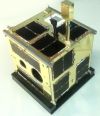 |
BRITE-PL
BRITE-PL 1
#39431
(2013-066R) |
BRITE-PL is a mission
planned to make photometric observations of some of
the brightest stars in the sky in order to examine these
stars for variability. The observations will have a
precision at least 10 times better than achievable using
ground-based observations, and it is packaged inside
a CanX-class nanosatellite. BRITE-PL features a UHF
downlink at 437.365 MHz and an S-band downlink at 2234.4
MHz. |
Nov.
21st 2013 |
10
kg |
 This
spectum plot of BRITE-PL at 2234.40 MHz was recorded
on January 3rd 2014 at 10:03UTC
while the satellite was changing the downlink data rate
and thus the spectrum. Kindly provided by Paul Marsh
M0EYT. This
spectum plot of BRITE-PL at 2234.40 MHz was recorded
on January 3rd 2014 at 10:03UTC
while the satellite was changing the downlink data rate
and thus the spectrum. Kindly provided by Paul Marsh
M0EYT.
|
  This recording
and spectum plot of BRITE-PL at 2234.40 MHz was recorded
on January 4th 2014 at 10:58UTC
while the satellite was changing the downlink data rate
and thus the spectrum. Kindly provided by Paul Marsh
M0EYT. This recording
and spectum plot of BRITE-PL at 2234.40 MHz was recorded
on January 4th 2014 at 10:58UTC
while the satellite was changing the downlink data rate
and thus the spectrum. Kindly provided by Paul Marsh
M0EYT.
|
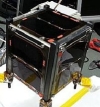
|
HumSAT
D
#39433
(2013-066T) |
HumSAT-D was built by
the University of Vigo in Spain. The 1U cubesat transmits
on 437.325 MHz in CW and GMSK-1200bps. It transmits
only when in sunlight either a CW beacon with different
parameter of the satellite or every 150 seconds a telemetry
signal with all the housekeeping parameters. A second
UHF downlink frequency designated to HumSAT D is 437.525
MHz. |
Nov.
21st 2013 |
1
kg |
 Jan PE0SAT
received the CW and 1200bd AFSK downlink signal of HumSat-D
on November 21st 2013 at 11:58
UTC on 437.331 MHz. Recording kindly provided by Jan
van Gils PE0SAT. Jan PE0SAT
received the CW and 1200bd AFSK downlink signal of HumSat-D
on November 21st 2013 at 11:58
UTC on 437.331 MHz. Recording kindly provided by Jan
van Gils PE0SAT.
|
 Mike
DK3WN received the 1200bd GMSK downlink signal of HumSAT-D
on January 31st 2014 at 11:00
UTC. Recording kindly provided by Mike DK3WN. Mike
DK3WN received the 1200bd GMSK downlink signal of HumSAT-D
on January 31st 2014 at 11:00
UTC. Recording kindly provided by Mike DK3WN.
|
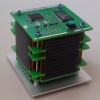
|
WREN
#39435
(2013-066V) |
Wren
is a crowd-funded femto-satellite by start-up company
STADIKO to test miniaturized µPP-Thrusters, 3-axis
control and a new image based navigation system in a
satellite built to the 1U PocketQub form factor (5 cm × 5 cm × 5 cm).
It is equipped with a camera system in order to remotely
take pictures of the earth, the sun and deep space objects.
The satellite was deployed from the Italian UniSat 5
satellite from a MR-FOD (Morehead Roma Femtosat Orbital
Deployer) deployer.
WREN was supposed to transmit telemetry
in 1200bps FSK or a CW beacon or SSTV pictures at 437.405
MHz.
No signal reports were received after
its launch. |
Nov. 21st
2013 |
0.25 kg |
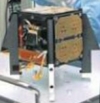
|
VELOX-PII
VELOX-P2
#39438
(2013-066Y) |
VELOX-PII is a picosatellite
built by students at Nanyang Technological University
(NTU) in Singapore. VELOX-P2 is used to qualify several
in-house built hardware and software such as the fault
tolerant power system, attitude determination &
control algorithms, fine sun sensor, solar panel etc.
It transmits on 145.980 MHz telemetry
with 1200bps AX.25 BPSK as well as a CW beacon. The
uplink frequency is 437.305 MHz. |
Nov.
21st 2013 |
1.33
kg |
 Mike
DK3WN received the CW signal of VELOX-P2 on December
5th 2013 at 19:20 UTC. Recording
kindly provided by Mike DK3WN. Mike
DK3WN received the CW signal of VELOX-P2 on December
5th 2013 at 19:20 UTC. Recording
kindly provided by Mike DK3WN.
|

|
First-MOVE
MOVE 1
#39439
(2013-066Z) |
The name MOVE is an acronym
that stands for “Munich Orbital Verification Experiment”.
The downlink frequency is 145.970 MHz, the uplink frequency
is 435.520 MHz. First-MOVE transsmits 60 seconds a CW
beacon and then 60 seconds a 1200 baud BPSK telemetry
signal in AX.25. |
Nov.
21st 2013 |
1
kg |
 Francisco
EA7ADI received the CW signal of MOVE-1 on May 9th2015
at 11:00 UTC. Recording kindly provided by Francisco
EA7ADI. Francisco
EA7ADI received the CW signal of MOVE-1 on May 9th2015
at 11:00 UTC. Recording kindly provided by Francisco
EA7ADI.
|
 On July
31st 2015 at 09:23 UTC Francisco
EA7ADI also received the CW downlink signal of FirstMove
on 145.970 MHz. Recording kindly provided by Francisco
EA7ADI. On July
31st 2015 at 09:23 UTC Francisco
EA7ADI also received the CW downlink signal of FirstMove
on 145.970 MHz. Recording kindly provided by Francisco
EA7ADI.
|
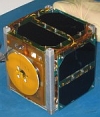
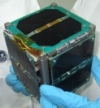
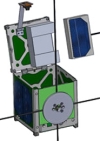
|
PUCP-Sat-1
PUCPSAT 1
#39442
(2013-066AC) |
PUCPSat-1
is the first satellite from Peru. This 1U-cubesat was
built by the Institute for Radio Astronomy of the Pontificia
Universidad Catolica del Peru (INRAS-PUCP). The 1270g
satellite will be deployed from the Italian UniSat-5
satellite and will later deploy itself the 127g Pocket-PUCP
picosatellite. PUCP-Sat-1 is planned to transmit and
receive on 2m at 145.820 MHz (1200Bd AFSK/AX.25/narrow
FM) as well as on 70cm at 437.200 MHz (OOK/12wpm).
No signal reports were received after
its launch. |
Nov. 21st
2013 |
1
kg |
 |
HiNCube
#39445
(2013-066AF) |
HINCube is
the first student satellite in the ANSAT program. The
satellite is being built by students at Narvik University
College (HiN) in Norway. HiNCube is a one unit CubeSat
10x10x10cm. The satellite is payload consist of
a camera which will be used to take pictures of the
earth. HiNCube features a downlink at 437.305 MHz.
I am searching for sound files. Please
send them to
 |
Nov. 21st
2013 |
1
kg |
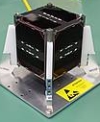

|
UWE-3
#39446
(2013-066AG) |
UWE-3 was built by the
University Wuerzburg in Germany. The main mission objectives
of UWE-3 are to demonstrate the use of a real-time miniature
attitude determination and control system on-board the
satellite, using a variety of sensors, magnetic torques
and one reaction wheel. It was successfully launched
with a Dnepr Launch Vehicle from Yasny Launch Base on
Nov. 21st at 07:11 UTC.
The frequency of UWE-3 is 437.385
MHz. The AX.25 telemetry signal is modulated at 9600
baud GMSK. Alternatively UWE-3 can also transmit in
CW and 1200bps FSK. Sometime later the frequency was
changed to 436.400 MHz. |
Nov.
21st 2013 |
1
kg |
 On July
18th 2014 at 20:57 UTC Darko
9A3LI received the 9600 baud data signal of UWE-3 at
436.400 MHz. Recording kindly provided by Darko 9A3LI. On July
18th 2014 at 20:57 UTC Darko
9A3LI received the 9600 baud data signal of UWE-3 at
436.400 MHz. Recording kindly provided by Darko 9A3LI.
|
 On
July 18th 2014 at 20:59 UTC
Davide IW0HLG received the signal of UWE-3. Waterfall
plot and decoded telemetry On
July 18th 2014 at 20:59 UTC
Davide IW0HLG received the signal of UWE-3. Waterfall
plot and decoded telemetry  kindly
provided by Davide IW0HLG. kindly
provided by Davide IW0HLG.
|
  On
July 21st 2014 at 09:40 UTC
Davide IW0HLG received the 9600bd signal of UWE-3 on
436.395 MHz. Recording and waterfall plot kindly provided
by Davide IW0HLG. On
July 21st 2014 at 09:40 UTC
Davide IW0HLG received the 9600bd signal of UWE-3 on
436.395 MHz. Recording and waterfall plot kindly provided
by Davide IW0HLG.
|
 Enclosed
signal from UWE-3 was received and recorded on April
2nd 2015 at 10:01 UTC by Francisco
EA7ADI. Recordings kindly provided by Francisco EA7ADI. Enclosed
signal from UWE-3 was received and recorded on April
2nd 2015 at 10:01 UTC by Francisco
EA7ADI. Recordings kindly provided by Francisco EA7ADI.
|
 The signal
from UWE-3 was received again and recorded on May 1st
2015 at 09:57 UTC by Francisco EA7ADI. Recordings kindly
provided by Francisco EA7ADI. The signal
from UWE-3 was received again and recorded on May 1st
2015 at 09:57 UTC by Francisco EA7ADI. Recordings kindly
provided by Francisco EA7ADI.
|
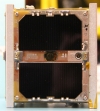
|
MCubed-2
#39469
(2013-072H) |
M-Cubed2 is a mission
designed around flight evaluation of a NASA JPL image
processing FPGA called COVE. The satellite provides
pictures of Earth for processing, power, and data handling.
M-Cubed2 is a re-flight of the COVE experiment with
updated avionics after the original M-Cubed satellite
accidentally docked with another cubesat shortly after
launch, losing the ability to transmit in the process.
MCubed-2 transmits telemetry every 10 seconds in 9600bps
GMSK at 437.485 MHz. Antenna polarization is linear. |
Dec.
6th 2013 |
1
kg |
 Mike
DK3WN received the 9600bd GMSK signal of MCubed-2 on
December 11th 2013 at 06:42
UTC. Recording kindly provided by Mike DK3WN. Mike
DK3WN received the 9600bd GMSK signal of MCubed-2 on
December 11th 2013 at 06:42
UTC. Recording kindly provided by Mike DK3WN.
|
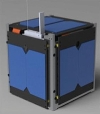
|
IPEX
CP-8
#39471
(2013-072K) |
IPEX (Intelligent Payload
Experiment) is a Cubesat built by the Californoa Polytechnic
State University. Its mission is to demonstrate operation
of autonomous instrument processing, downlink operations,
and ground station operations, utilizing the SpaceCube
Mini payload processing unit to validate a reduction
in data product downlink. IPEX transmits on 437.320
MHz 9600bps GMSK and CW mode. |
Dec.
6th 2013 |
1
kg |
 Mike
DK3WN received the donwlink signal of IPEX CP-8 on January
16th 2014 at 09:02 UTC. Recording
kindly provided by Mike DK3WN. Mike
DK3WN received the donwlink signal of IPEX CP-8 on January
16th 2014 at 09:02 UTC. Recording
kindly provided by Mike DK3WN.
|
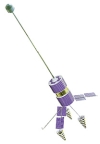
|
COSMOS
2488 or 2489 or 2490
Strela-3M #7, #8, #9
#39482,
#39483,
or #39484
(2013-076 A, B or C) |
Cosmos 2488, 2389 anf
2490 were launched by a Rokot-KM rocket from Plesetsk
December 25th2015. At the end
of 2013 they were still too close to be discernable. |
Dec.
25th 2013 |
225
kg |
  COSMOS
2488/89/90 was received by Roland Proesch DF3LZ on December
26th 2013 at 15:51 UTC on 245.000
MHz in USB. COSMOS
2488/89/90 was received by Roland Proesch DF3LZ on December
26th 2013 at 15:51 UTC on 245.000
MHz in USB.
The spectrogam shows the ID of the
satellite. Sound file kindly provided by Roland Proesch
DF3LZ.
|
 COSMOS
2488/89/90 was received by Roland Proesch DF3LZ on December
26th 2013 at 19:45 UTC on 245.000
MHz in USB. COSMOS
2488/89/90 was received by Roland Proesch DF3LZ on December
26th 2013 at 19:45 UTC on 245.000
MHz in USB.
The spectrogam shows the ID of the satellite.
Sound file kindly provided by Roland Proesch DF3LZ.
|
 COSMOS
2488/89/90 was received by Roland Proesch DF3LZ on December
26th 2013 at 20:03 UTC on 245.000
MHz in USB. COSMOS
2488/89/90 was received by Roland Proesch DF3LZ on December
26th 2013 at 20:03 UTC on 245.000
MHz in USB.
The spectrogam shows the ID of the satellite.
Sound file kindly provided by Roland Proesch DF3LZ.
|
 COSMOS
2488/89/90 was received by Roland Proesch DF3LZ on December
27th 2013 at 19:23 UTC on 388.6875
MHz in USB. COSMOS
2488/89/90 was received by Roland Proesch DF3LZ on December
27th 2013 at 19:23 UTC on 388.6875
MHz in USB.
The spectrogam shows the ID of the satellite.
Sound file kindly provided by Roland Proesch DF3LZ.
|
 COSMOS
2488/89/90 was received by Roland Proesch DF3LZ on December
27th 2013 at 20:34 UTC on 388.6875
MHz in USB. COSMOS
2488/89/90 was received by Roland Proesch DF3LZ on December
27th 2013 at 20:34 UTC on 388.6875
MHz in USB.
The spectrogam shows the ID of the satellite.
Sound file kindly provided by Roland Proesch DF3LZ.
|
 COSMOS
2488/89/90 was received by Roland Proesch DF3LZ on December
27th 2013 at 20:34 UTC on 388.6875
MHz in USB. COSMOS
2488/89/90 was received by Roland Proesch DF3LZ on December
27th 2013 at 20:34 UTC on 388.6875
MHz in USB.
The spectrogam shows the ID of the satellite.
Sound file kindly provided by Roland Proesch DF3LZ.
|
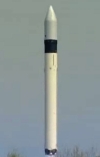 |
COSMOS
2491
KOSMOS 2491
RS-46
#39497
(2013-076E) |
KOSMOS 2491 is a Russian
military satellite.
End of 2014 it was reported
by Dmitry Pashkov R4UAB that this satellite also carries
RS-46 operating a CW downlink at 435.465 MHz and 435.565
MHz. |
Dec.
25th 2013 |
50
kg |
 Enclosed
data signal from COSMOS-2491 for the DOKA-B ground stations
was received on 435.465 MHz during orbit #7554 on August
26th 2015 by Jean-Pierre F5YG.
Recording kindly provided by Jean-Pierre Godet F5YG. Enclosed
data signal from COSMOS-2491 for the DOKA-B ground stations
was received on 435.465 MHz during orbit #7554 on August
26th 2015 by Jean-Pierre F5YG.
Recording kindly provided by Jean-Pierre Godet F5YG.
|


|
AIST-1
RS-41
147 KS
#39492
(2013-078C) |
AIST-1 is
a russian microsatellite developed by a group of students,
postgraduates and scientists of Samara Aerospace University
in cooperation with TsSKB-Progress. The satellite will
measure the geomagnetic field, test the new small space
vehicle bus, test methods to decrease microaccelerations
to a minimum level and measure micrometeoroids of natural
and artificial origin. It features uplink antennas for
145 MHz and downlink antennas for UHF.
AIST-1 transmits a CW beacon on 435.265
MHz using the callsign RS41. |
Dec.
28th 2013 |
53
kg |
 Mike
DK3WN received the CW signal of AIST-1 on January 2nd
2014 at 15:20 UTC. Recording kindly provided by Mike
DK3WN. Mike
DK3WN received the CW signal of AIST-1 on January 2nd
2014 at 15:20 UTC. Recording kindly provided by Mike
DK3WN.
|
Picture |
Object
name
#NORAD |
Description |
Launch
Date |
Weight |